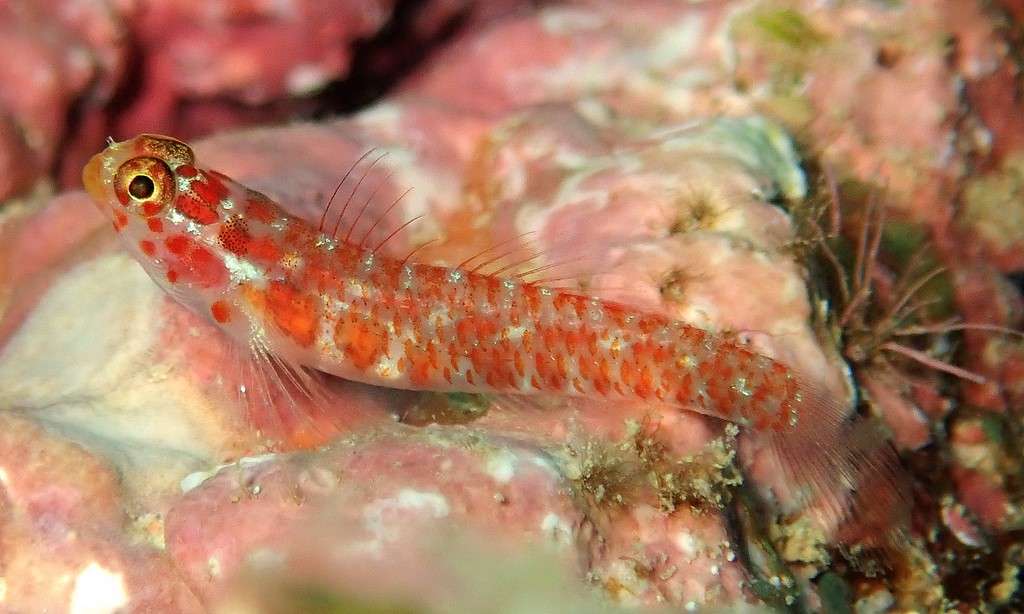EVIOTA MELASMA - (LACHNER & KARNELLA, 1980)
Picture courtesy of: Alain Daoulas
Actinopterygii (Gigaclass) > Actinopteri (Class) > Teleostei (Subclass) > Gobiiformes (Order) > Gobioidei (Suborder) > Gobiidae (Family) > Gobiinae (Subfamily) > Eviota (Genus)
Black-spotted pygmy-goby, Headspot Eviota, Headspot dwarfgoby, Melasma pygmy goby, Akahoshi-isohaze, アカホシイソハゼ, 흑점풀비늘망둑, 黑體磯塘鱧,
Description
Dorsal spines (total): 6-7; Dorsal soft rays (total): 8-10; Anal spine: 1; Anal soft rays: 8-9; Pectoral fin rays: 15-18, 10th-16th rays branched; Pelvic fin rays: I, 4; Caudal fin rays: 11-14 (usually: 12); Longitudinal scale series: 23-25; Ctenoid scales, absent on head and breast; Separated pelvic fins, thin membrane joining bases; Depth of body: 6.5-7.7 in SL. First and second dorsal spines of males and females may be elongate and filamentous, the longest extending to the end of the second dorsal fin base Max. length: 3.0 cm SL. Depth range: 1 - 20 m.
Color
Semi-transparent body with red-brown internal bars; Irregular reddish blotches on nape; Presence of intense black spot above gill opening; Three red blotches separated by white or yellow bars on side of belly; Base of pectoral fin with narrow white band.
Etymology
Eviota: from Greek prefix, ev-, eu-, = good or well, very + from Greek letter, iota = smallest letter in the Greek alphabet and often figuratively used to describe anything small or insignificant. Referring to Eviota epiphanes (Jenkins, 1903), which, at 1.0-1.9 cm in length, Jenkins claimed was the “smallest vertebrate that has up to this time been described”.
melasma: from Latin, melasma = black spot. Referring to dark occipital spot on each side of head.
Original description: Eviota melasma Lachner & Karnella, 1980 - Type locality: South side, about 2 miles east of its west end, Endeavour Reef, Australia.
Distribution
Southeastern Indian Ocean, western West Pacific: eastern Indonesia, east to Marshall Islands and Fiji, north to Ryukyu Islands (Japan), south to northern Australia and New Caledonia.
Biology
Inhabits coastal and offshore reefs, including reef slopes, spur and groove, patch reefs, sand slopes and rocky substrates. Solitary or in groups, resting at bottom. Spawning appears to be repeated on a regular cycle, semilunar or every 14 days.
Similar species
Eviota fallax (Greenfield & Allen, 2012) - Reported from West Pacific: Indonesia (Bali, West Papua, Banda, and Sangihe Island), Papua New Guinea (Kimbe, New Britain), Solomon Islands, Philippines, Micronesia (Chuuk, Yap, and Ngulu Atoll), and Japan (Ryukyu Islands).
Eviota karaspila (Greenfield & Randall, 2010) - Reported from Fiji and Tonga.
Eviota pictifacies (Greenfield & Erdmann, 2017) - Reported from Eastern Indian Ocean: Sumbawa (Indonesia), presumably more widespread in Lesser Sunda Islands.
Last update: 23, July 2023
Actinopterygii (Gigaclass) > Actinopteri (Class) > Teleostei (Subclass) > Gobiiformes (Order) > Gobioidei (Suborder) > Gobiidae (Family) > Gobiinae (Subfamily) > Eviota (Genus)
Black-spotted pygmy-goby, Headspot Eviota, Headspot dwarfgoby, Melasma pygmy goby, Akahoshi-isohaze, アカホシイソハゼ, 흑점풀비늘망둑, 黑體磯塘鱧,
Description
Dorsal spines (total): 6-7; Dorsal soft rays (total): 8-10; Anal spine: 1; Anal soft rays: 8-9; Pectoral fin rays: 15-18, 10th-16th rays branched; Pelvic fin rays: I, 4; Caudal fin rays: 11-14 (usually: 12); Longitudinal scale series: 23-25; Ctenoid scales, absent on head and breast; Separated pelvic fins, thin membrane joining bases; Depth of body: 6.5-7.7 in SL. First and second dorsal spines of males and females may be elongate and filamentous, the longest extending to the end of the second dorsal fin base Max. length: 3.0 cm SL. Depth range: 1 - 20 m.
Color
Semi-transparent body with red-brown internal bars; Irregular reddish blotches on nape; Presence of intense black spot above gill opening; Three red blotches separated by white or yellow bars on side of belly; Base of pectoral fin with narrow white band.
Etymology
Eviota: from Greek prefix, ev-, eu-, = good or well, very + from Greek letter, iota = smallest letter in the Greek alphabet and often figuratively used to describe anything small or insignificant. Referring to Eviota epiphanes (Jenkins, 1903), which, at 1.0-1.9 cm in length, Jenkins claimed was the “smallest vertebrate that has up to this time been described”.
melasma: from Latin, melasma = black spot. Referring to dark occipital spot on each side of head.
Original description: Eviota melasma Lachner & Karnella, 1980 - Type locality: South side, about 2 miles east of its west end, Endeavour Reef, Australia.
Distribution
Southeastern Indian Ocean, western West Pacific: eastern Indonesia, east to Marshall Islands and Fiji, north to Ryukyu Islands (Japan), south to northern Australia and New Caledonia.
Biology
Inhabits coastal and offshore reefs, including reef slopes, spur and groove, patch reefs, sand slopes and rocky substrates. Solitary or in groups, resting at bottom. Spawning appears to be repeated on a regular cycle, semilunar or every 14 days.
Similar species
Eviota fallax (Greenfield & Allen, 2012) - Reported from West Pacific: Indonesia (Bali, West Papua, Banda, and Sangihe Island), Papua New Guinea (Kimbe, New Britain), Solomon Islands, Philippines, Micronesia (Chuuk, Yap, and Ngulu Atoll), and Japan (Ryukyu Islands).
Eviota karaspila (Greenfield & Randall, 2010) - Reported from Fiji and Tonga.
Eviota pictifacies (Greenfield & Erdmann, 2017) - Reported from Eastern Indian Ocean: Sumbawa (Indonesia), presumably more widespread in Lesser Sunda Islands.
Last update: 23, July 2023
